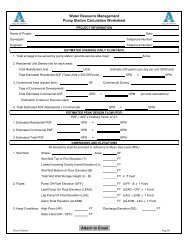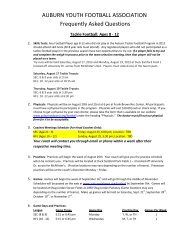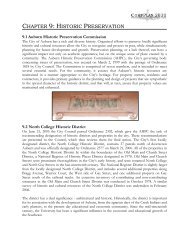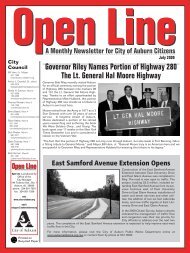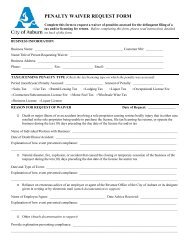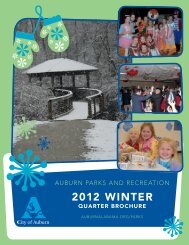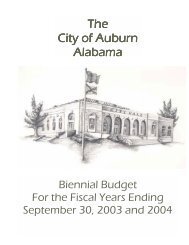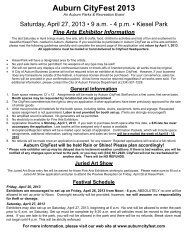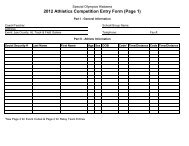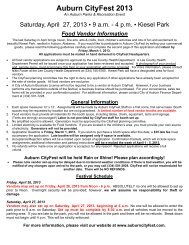North College Street Historic District Interactive Map - City of Auburn
North College Street Historic District Interactive Map - City of Auburn
North College Street Historic District Interactive Map - City of Auburn
You also want an ePaper? Increase the reach of your titles
YUMPU automatically turns print PDFs into web optimized ePapers that Google loves.
original Federal Milk and Meat Inspection Law and the bill which<br />
created the Office <strong>of</strong> State Veterinarian in Alabama, an <strong>of</strong>fice which he<br />
held until his death in 1935. The house was also the home <strong>of</strong> Lt. Gen.<br />
Lewis A. Pick, who married Dr. Cary’s daughter, Alice Cary. General<br />
Pick built the famous Ledo Road in Burma during World War II. In<br />
1941-43, he authored the Comprehensive Plan for Development <strong>of</strong> the<br />
Missouri River Basin.<br />
Inventory <strong>of</strong> October 19, 1978 (prior to National Register designation, Old Main<br />
and Church <strong>Street</strong> <strong>Historic</strong> <strong>District</strong>)<br />
A simple Greek Revival raised cottage with a mansard ro<strong>of</strong> built in<br />
1948 by James W. Kidd. The lower floor is <strong>of</strong> handmade brick and the<br />
upper <strong>of</strong> 6” pine boards. The house is <strong>of</strong> virgin heart pine with wooden<br />
pegs. A mahogany spiral interior stair connects the central halls. There<br />
are porticos on the west (front) and east facades. The east one has been<br />
enclosed. The house was restored in 1953 and is listed with HABS.<br />
The house was designated a National <strong>Historic</strong> Building by the <strong>Historic</strong><br />
Building Survey in 1936 (project 16—540).<br />
One <strong>of</strong> six Greek Revival homes along <strong>North</strong> <strong>College</strong> <strong>Street</strong> (formerly<br />
Old Main <strong>Street</strong>) that were situated on well-separated Lots. The lower<br />
story is <strong>of</strong> brick, with the main upper floor being <strong>of</strong> clapboard. The<br />
facade has three bays with a full-width portico, four square columns,<br />
six-paneled double doors with a transom and sidelights, a truncated<br />
hipped ro<strong>of</strong>, and two interior chimneys. It was built on a central hall<br />
plan and originally had matching porticoes on both the east and west.<br />
The rear portico (east) was originally the main entrance but was<br />
converted to a sun porch below (1916) and to a laundry room and baths<br />
above (1953). The most notable feature is the free-standing interior<br />
spiral stair, made <strong>of</strong> solid mahogany and held together with wooden<br />
pegs.<br />
Back to <strong>Map</strong><br />
The most noted house <strong>of</strong> the ante-bellum period is the 1848 Halliday-<br />
Cary-Pick House (19) on <strong>North</strong> <strong>College</strong> <strong>Street</strong>. Built by James Kidd,<br />
who also possibly Constructed the nearby Hardin-Poucher House (22),<br />
it is a good example <strong>of</strong> Greek Revival influence on the traditional raised<br />
cottage. After changing hands several times, the house was occupied by<br />
the Dickinson Halliday family from 1854 until 1897, at which time it<br />
was purchased by Dr. Charles Allen Cary.<br />
Dr. Cary, founder <strong>of</strong> the School <strong>of</strong> Veterinary Medicine at <strong>Auburn</strong><br />
University, was famous for his discovery that the southern cattle tick<br />
caused the widespread and deadly cattle disease which thwarted the<br />
possibility <strong>of</strong> raising cattle in the South. With the eradication <strong>of</strong> the tick,<br />
the cattle industry became a lucrative enterprise in Alabama, especially<br />
significant to post-Civil War economic recovery. Dr. Cary also drafted<br />
legislation resulting in the first federal meat and milk inspection<br />
regulations anc in the creation <strong>of</strong> the position <strong>of</strong> State Veterinarian, an<br />
<strong>of</strong>fice which he held until his death in 1935. In 1962 he was named to<br />
the Alabama Hail <strong>of</strong> Fame.<br />
In 1953 the house underwent major restoration work under the<br />
direction <strong>of</strong> Dr. Cary’ s daughter Alice, who still resides there today.<br />
Her first husband was Lieutenant General Lewis A. Pick, noted as the<br />
builder <strong>of</strong> the Ledo Road in Burma during World War II and as the<br />
author <strong>of</strong> the plan for the development <strong>of</strong> the Missouri River Basin.<br />
Photos courtesy <strong>of</strong> the <strong>Historic</strong> American Buildings survey, Survey number HABS AL-540



